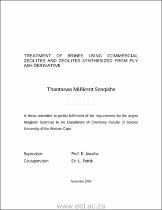| dc.contributor.advisor | Iwuoha, E. | |
| dc.contributor.author | Sonqishe, Thantaswa Millicent | |
| dc.date.accessioned | 2022-03-16T10:09:38Z | |
| dc.date.available | 2022-03-16T10:09:38Z | |
| dc.date.issued | 2008 | |
| dc.identifier.uri | http://hdl.handle.net/11394/8905 | |
| dc.description | >Magister Scientiae - MSc | en_US |
| dc.description.abstract | South Africa is one of the countries that have scarce natural resources that they have to preserve what is available at their disposal. South Africa is also fast becoming one of the countries with major industrial development. In South Africa, electricity is primarily generated by coal-fired power stations which are mostly concentrated in the Mpumalanga, Gauteng and Limpopo Provinces. These power stations use the concept of burning coal to produce electricity which generates a lot of fly ash and effluent water as a waste material. There are also active coal mines supplying coal to the power stations and abandoned coal mines that are a source of Acid Mine Drainage which is a threat to our
environment if discharged untreated as it can pollute receiving streams, aquifers and can even kill aquatic and fish plant. The objectives of this project was to ameroliate two waste materials, namely Acid Mine Drainage and Fly Ash and recover the solid residues for conversion into an adsorbent to treat brine. The solid residues were then converted into zeolite P through low temperature hydrothermal treatment. The adsorption capacity of the solid residues, zeolite P derived from the solid residues was compared to the commercial zeolite Y and fresh Arnot fly ash. The quality of the resulting water was assessed using different analytical methods before the reaction with adsorbents and after the reaction and a comparison was done based on the removal efficiency of elements. Zeolite P from solid residues was successfully synthesized as confirmed by XRD, BET and FTIR. Brine treatment with fly ash, solid residues, zeolite P and commercial zeolite Y adsorbents was done concentration on the following major elements Na, K, Mg, Ca and Si. Zeolite P had higher or similar removal efficiency that the commercial zeolite Y for the following elements K, Ca and Mg. Fly ash is the only adsorbent that managed to reduce the concentration of Na in brine and also had a good removal efficiency of Mg. Si leached out of all the adsorbents which could be ascribed to Si being the major component of these adsorbents which could indicate some dissolution of these adsorbents under the conditions tested. Overall, zeolite P did not completely remove the major elements, especially for Na, but did result in a cleaner waste stream which would improve brine processing. | en_US |
| dc.language.iso | en | en_US |
| dc.publisher | University of the Western Cape | en_US |
| dc.subject | Total Dissolved Solids | en_US |
| dc.subject | Acid mine drainage ( AMD) | en_US |
| dc.subject | Fly Ash (FA) | en_US |
| dc.subject | Reverse Osmosis (RO) | en_US |
| dc.subject | Electricity Supply Commission (Eskom) | en_US |
| dc.subject | Coal Fly Ash ( (CFA ) | en_US |
| dc.subject | American Society for Testing and Materials (ASTM ) | en_US |
| dc.subject | (XRD) X-ray diffraction | en_US |
| dc.subject | (AD) Acid Drainage | en_US |
| dc.subject | (ARD) Acid Rock Drainage | en_US |
| dc.title | Treatment of brines using commercial zeolites and zeolites synthesized from fly ash derivative | en_US |
| dc.rights.holder | University of the Western Cape | en_US |

